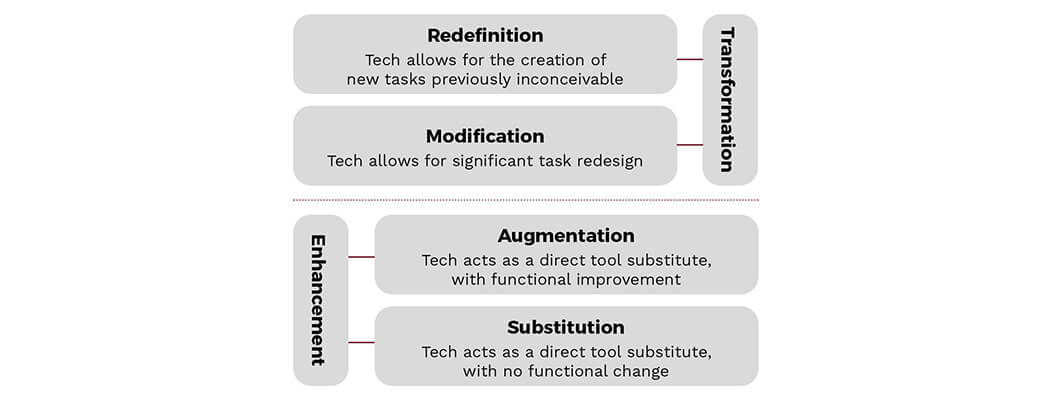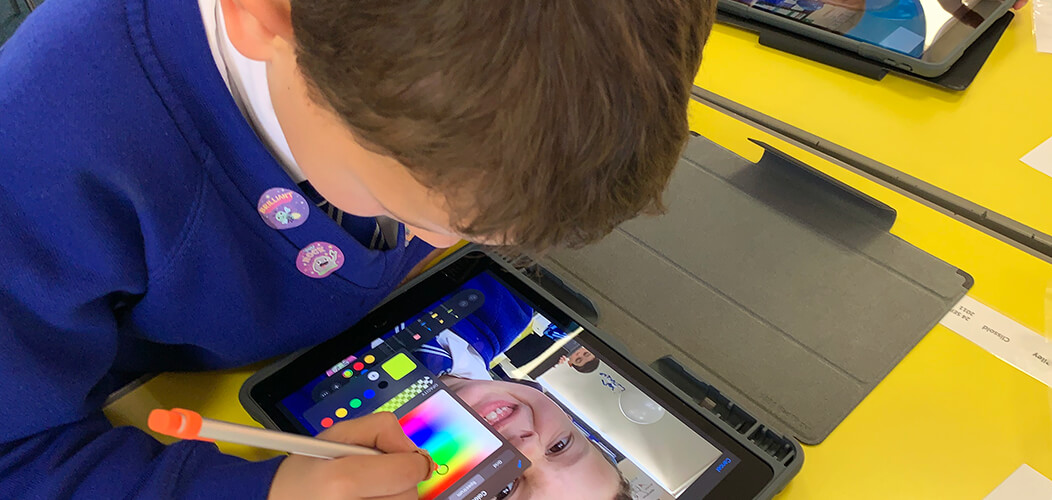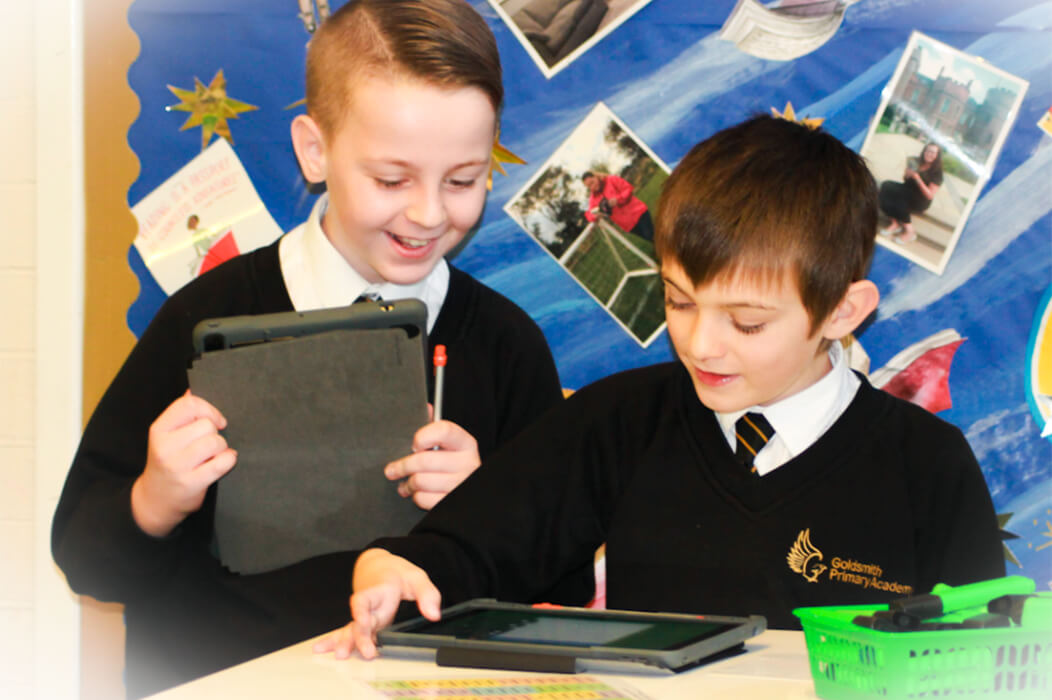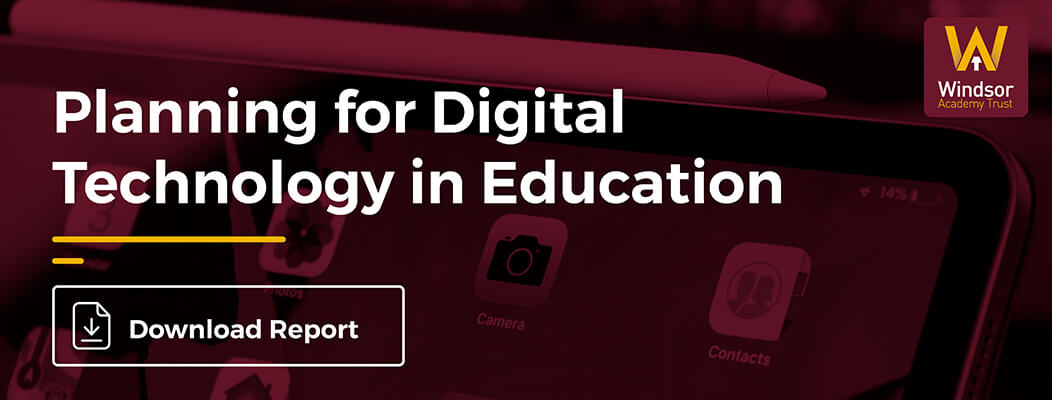
Planning for Digital Technology in Education
15th April 2021 – Tags: Education Technology, iPads for Learning
By Kirsty Tinsley, Research Lead, Windsor Academy Trust
We believe in digital technology’s potential to transform students' learning experience both in the classroom and beyond. Technology enables new ways of collaborating, developing knowledge and live assessment while preparing students for life in an increasingly digital world.
For teachers, opportunities exist to reimagine teaching methods, learning, and working in more efficient ways to support wellbeing. Yet, the case for digital technology in schools has limited research evidence.
The extent to which digital devices have enhanced student engagement and changed ways of teaching teachers’ pedagogy is, as yet, not well understood (Diemer et al, 2013 cited in Geer 2017). Hattie’s metastudy indicates the use of technology providing moderate effect sizes - 0.57 effect size for SEN and 0.55 effect size for other subjects (Hattie 2020).
Indeed, only 44% of primary and 31% of secondary schools in England report that the implementation of education technology has helped them achieve their original objectives (BESA 2017). However, it is also argued that digital technology has positive impact when it is embedded in a well-designed learning system (US Office of Educational Technology 2014, cited in Lewin et al 2019) with a laser focus on research to inform curriculum, pedagogy and CPD.
Perhaps the lack of success in embracing education technology is because, in many cases, technology has been implemented without the requisite thinking on how it will close gaps for students and how it can enhance teaching and learning.
Education technology should be ‘the final piece of the process, not its starting point’ (Selwyn, 2019). So before introducing technology into our schools, we began by reviewing the literature base around technology in education to allow us to power up teaching and learning in school and at home.
This blog provides a summary of our literature review, identifying how digital technology in education can be successfully implemented through a planned and research-based approach to enhance teaching and learning.
You will find five key takeaways below, followed by the full blog and a link to download the report.
Five Key Takeaways
1. Pedagogical and Cognitive Theory
It is vital to root any learning activity in pedagogical theory, just as in any lesson. Having a secure knowledge base to enable students to select/understand relevant information online is crucial (Fullan 2020, Willingham 2006). Beware of split attention; ensure that students are learning and remembering the content that you intended rather than how to use an exciting new app (Christodulu 2019).
2. Teacher and Student Training – Implementation
Poor implementation is a key reason digital technology fails to meet its potential to improve learning (EEF 2019). Teachers require training in the range of pedagogical approaches for use to critically analyse and ascertain the best approach for student learning (Henderson 2012). Surprisingly, although digital technology offers intuitive tools, students take time to learn how to use iPads for their own learning (Lam 2011). Check that all learners have the tech skills to reduce the risk that technology becomes a tool that widens the gap between successful learners and their peers (EEF 2019).
3. Technology and Assessment
There are areas of real potential here: increased accuracy of assessment, data collection speed informing teachers’ decision-making, reduced workload, stealth assessment and e-portfolios. Technology is most beneficial if it supplements and is aligned to other forms of feedback (EEF 2019).
4. Technology and Differentiation/Personalisation
Tutoring systems can provide opportunities for students at risk of falling behind or for those who have missed areas of content and provide adaptive content. Effective delivery requires staff oversight and help with student organisation (EEF 2019, Pane 2017).
5. Notes of Caution
Unintended and unhelpful impact on existing activity, beware of students wholly replacing previously successful learning techniques (EEF 2019). Multitasking, eg using a number of apps simultaneously, can be a distraction from linear thought and deep thinking (p230 Greenfield 2015, Carr 2006). Only 1 in 9 students are able to distinguish fact from opinion, hence without considerable guidance from teachers, it is unlikely that students will be able to navigate the world of online learning (Fullan 2020, OECD 2018).
The Importance of Pedagogical and Cognitive Theory
To improve learning, technology must be used in a way that is informed by effective pedagogy.
Instead of simply considering what a successful system looks like when considering any new intervention, we should ‘consider how humans learn, what causes learning to happen’ (p.21 Christodulu 2019). Technology can help teachers model in new ways and provide opportunities to highlight how experts think and what they do. Still, it may be most effective when used as a supplement rather than a substitute for other forms of modelling (Lewin et al 2019).
The 2019 EEF metastudy (Lewin et al 2019) sees potential for edtech to increase the quality and quantity of practice that pupils undertake, both inside and outside of the classroom, as engaging and motivating for pupils. Some forms of technology can also enable teachers to adapt practice effectively, for example, by increasing the challenge of questions as pupils succeed or by providing new contexts in which students are required to apply new skills. Using technology to support retrieval practice and self-quizzing can increase retention of key ideas and knowledge (Lewin et al 2019).
While organisations such as Google, Microsoft and Apple have developed project based learning programmes that use apps such as i-movie to promote creativity and individualisation, this is somewhat countered by cognitive science theory which suggests ‘memory is the residue of thought’ (Willingham 2006). That is, we must be clear on our learning objectives.
If students are thinking about how to use the apps that they are using then are they learning the subject content that we had set out to teach?
Henderson (cited in Geer et al 2017) indicates that having quick access to content empowers students to supplement what they may be learning in class with a wider variety of information. Indeed, Google’s teacher training resources suggest ‘we have access to every bit of info we need at all times. It is therefore no longer relevant to focus on teaching facts.’ (Google for Education, Search Smart 2019). However, this does not fit comfortably with cognitive science theory, which states that we need facts in long-term memory to think critically and assess new material sensibly (Kirschner 2006).
The PISA 2018 assessment revealed that even among 15-year-old students, on average across OECD countries, just one in nine students could distinguish between fact and opinion, based on implicit cues about the content or source of information. Thus, without considerable guidance and support from teachers, it is unlikely that students will be able to navigate the world of online learning on their own (Fullan 2020).

A Framework for EdTech Purpose
To date, several frameworks have been used to examine the general adoption and integration of technologies into the classroom eg TPACK framework, Replacement, Amplification and Transformation (RAT) and the framework of Substitution, Augmentation, Modification and Redefinition (SAMR) by Puentedura (2006) (all cited in Geer 2017).
The SAMR model (Puentedura 2006), which is used in studies of Geer et al (2017) and Moane (2019), consists of four clearly defined levels for the use of technology where a level can be selected to suit the purpose and need; making education technology use more meaningful for pupils’ learning and teacher planning.

The SAMR Model
This has been exemplified at Sandringham School, which introduced a Bring Your Own Device scheme Years 7 to 11 using the SAMR model to plan for and assess impact. It integrated blended learning into the whole-school teaching and learning strategy.
Their aims were ‘to foster independent, creative and resourceful learners, time-shifted and place-shifted learning, to extend learning beyond the confines of the classroom and the school day, to encourage collaborative and active learning, to personalise the curriculum and place no limits upon learning...The student pioneers of the blended learning programme finished their GCSE studies in summer 2018 and achieved excellent results in terms of attainment and progress...over 80% of staff and students and 77% of parents agreed that blended learning had added significantly to learning at school and home’ (Moane 2019).
In Geer’s (2017) study of four schools, the iPad features and the way the teachers implemented them using the SAMR model enabled the students to use iPads for research, communication and product creation. ‘Findings suggest that a structured professional learning program may assist some teachers to move from the enhancement to the transformation stage. While best practice is not evident as yet, and further research is needed in this emerging field, there are promising signs that iPad use will bring about a pedagogical shift supporting enhanced student learning’. (Geer 2017).
Implementation - Teacher Training
Students were clear in The Class of 2030 and the Life-Ready Learning report (cited in Fullan 2020) - they did not want to be taught by a ‘computer’. They valued the relationship they had with teachers who knew them and how they learn best.
Teacher-student relationships remain key to success. Education moving forward must not be an agenda of students learning on their own. Teacher-student partnerships and school settings remain essential elements of a future-focused learning model (Fullan 2020).
Poor implementation is a crucial reason that digital technology fails to meet its potential to improve learning (Lewin et al 2019).
Indeed, across Organisation for Economic Co-operation and Development (OECD) countries, only 65% of 15-year-olds are enrolled in schools whose principal considers that their teachers have the necessary technical and pedagogical skills to integrate digital devices in instruction OECD (Fullan 2019), highlighting training needs within education systems.
Across OECD countries, the least commonly implemented effective and valuable practices were:
- having a specific programme to promote collaboration amongst teachers on the use of digital devices (36%)
- having a scheduled time for teachers to meet to share, evaluate or develop instructional materials and approaches that use digital devices (44%)
- having a written statement specifically about the use of digital devices for pedagogical purposes at school (46%) (Fullan 2019).
A cautionary tale exists in the 2013 Los Angeles School District and Apple Pearson $1.3bn project. This project aimed to educate 700,000 students but failed due to limited teacher training and software faults (Lapowsky 2015, cited in Christodulu 2019).
Teachers require exposure to the range of pedagogical approaches that lend themselves to iPad use so that they can critically analyse and ascertain the best approach for student learning (Henderson and Yeow, 2012). In contrast, Burden et al (2012) suggest that formal training should be kept to a minimum and that the greatest benefits are likely to be evidenced through experimental learning, taking into account the time required for teachers to familiarise themselves with the technology (Geer 2017).
Implementation - Student Training
Although iPads are intuitive tools, and consequently, students appear to take little time to learn how to use them, they do not necessarily know how to effectively use them for their own learning (Lam at al, 2011 cited in Greer 2017).
Monitoring how technology is being used, including checking that all learners have the skills they need to use it effectively, is likely to reduce the risk that technology becomes a tool that widens the gap between successful learners and their peers (Lewin et al 2019). Training needs should be built into curriculum plans.

Technology and Assessment
Much of the literature suggests feedback and assessment should become more deeply embedded within the teaching process (Whitelock and Warburton, 2011; Pellegrino and Quellmalz, 2010). Indeed, ‘stealth assessment', assessments embedded within learning, have been found to reduce test anxiety and be less disruptive to the flow of learning (Shute et al, 2010).
Kleeman et al (2011) describe how embedded assessments can be used formatively as knowledge checks in various multimedia forms, such as wikis, social networking sites, blogs or web pages on computers or mobile devices. In this way, assessment is integrated into the learning process and utilises previous research showing that retrieval practice questions can be powerful motivators for learners (Oldfield et al 2012).
Using technology can increase the accuracy of assessment and the speed with which assessment information is collected. This has the potential to inform teachers’ decision-making and reduce workload. Technology can be used to provide feedback directly to pupils via programmes or interventions, but careful implementation and monitoring are necessary in all cases. Feedback via technology is likely to be most beneficial if it supplements, but is aligned to, other forms of feedback (Lewin et al 2019).
Technology can enable e-portfolios to track holistic learning and increase self and peer assessment and more assessment of group work and performance (Whitelock, 2010; Peacock, A; Berger, R). e-portfolios have been seen as a significant improvement over previous paper-based portfolios, both for practical (more time-efficient) and pedagogical (increased reflection and quicker feedback) reasons (Stone, 2012).
Technology can be used to solve the ‘the abstraction between what the teacher intends, and what the pupil understands’ by feedback (Lewin et al 2019). For example, St Margaret’s CE Primary, Withern, developed an approach using tablet computers to record verbal feedback over videos of annotations of pupils’ work. The pupils get two improvement points: a photo of their work side by side with an image of a model text and when improving their text, pupils can replay the teacher’s voice as often as they like. Unlike other modes of delayed feedback, the only intended audience is the pupil, so the feedback is focused on their needs and moving their learning forward (Lewin et al 2019).
However, results from other EEF trials illustrate that technology alone is not enough. The Learner Response System trial looked at hand-held electronic clickers’ regular use in Key Stage 2 mathematics lessons in 2014 and 2016. In response to the teacher’s questions, pupils could input the answer on the handset, and both pupils and teachers received immediate feedback. The high-quality study found no impact on Key Stage 2 results and identified teachers’ concerns about the feedback’s accuracy (Lewin et al 2019).
Technology and Collaboration
Collaboration is an interesting area for the creative use of technology. Burden et al (2012 cited in Geer 2017) found that having iPads in the classroom caused teachers to rethink their professional role leading to greater collaboration as co‐learners and pioneers with their students.
In Geer et al’s study of four schools adopting iPads (2017) data analysis from teacher and student interviews/surveys relating to pedagogy identified four main themes; collaboration, communication, self‐reliance/autonomy and authenticity, which were evidenced throughout the data as being aspects of change due to iPad use.

Technology and Differentiation/Personalisation of Learning
As advocated by Bloom (1984), personalising learning through one-one tuition showed students receiving one-one tuition made gains of two standard deviations compared to groups in classrooms, is cited by Zuckerberg as showing the value of personalised learning that is equivalent to eight additional months (Christodulu 2019). However, the RAND paper on personalisation of learning shows some of the negative effects when students are given too much control over their own learning. Some students were unable to organise their time to pace themselves through the work to completion. (Pane 2017).
Tutoring systems can provide additional learning opportunities for pupils at risk of falling behind or those who have missed content areas. These programmes offer an opportunity to provide cost-effective personalised support, and some claim to accurately assess pupils’ understanding and provide adaptive content.
Effective delivery requires some level of staff oversight, although a teacher can supervise the practice of pupils simultaneously. This is supported by a meta analysis of 84 reading programmes showing a small positive impact, but only with teacher supervision (Cheung 2012). However, most programmes are designed to be used as additional support, replacing other forms of catch-up intervention. In these cases, the evidence suggests that they are unlikely to be more effective than other support, and schools should consider what support is the most efficient and appropriate (Lewin et al 2019).
Technology and Learning Skills
The ability for technology to enhance students' learning skills with the aim of developing 21st Century citizens is explored by Summit Learning, an online learning platform which is funded by the Chan-Zuckerberg Foundation, as praised by Bill Gates. While Michael Fullan’s 6 competencies for future citizens (Collaboration, Creativity, Critical Thinking, Citizenship, Character, Communication) are articulated in the ‘Deep Thinking for New Pedagogies’ project (Fullan 2020).
Notes of Caution
Even when technology is introduced as an additional strategy outside of the classroom, it is valuable to consider whether it will have an unintended and unhelpful impact on existing activity. For example, the result recommending an online quiz website could lead students to cut back on other forms of revision unless the site was introduced with some guidance about an appropriate mix of revision strategies (Lewin et al 2019).
Monitoring how technology is being used, including checking that all students have the skills they need to use it effectively, is required to reduce the risk that technology becomes a tool that widens the gap between successful learners and their peers (Lewin et al 2019).
It is noteworthy that students attending schools with more computers per student scored lower in the PISA assessment than their peers in schools with fewer computers per student. Across OECD countries, one additional computer per student in a school was associated with a 6-point decline after accounting for socio-economic profiles (OECD 2020), suggesting that it takes more than providing technology to improve learning.
Greenfield warns against multitasking which is promoted by tech devices eg hyper-text within reading or using several apps simultaneously as a distraction from linear thought and deep thinking. Greenfield also notes that students seem to prefer the medium of print rather than screen for ‘effortful learning’ (p230 Greenfield 2015; Carr 2006).
In short, in seeking to introduce digital technology, it is vital to plan for and monitor the use of technology carefully during implementation to support effective pedagogy and discover unintended consequences.
How we have Introduced Digital Technology to Power Up Learning
Across Windsor Academy Trust, we launched iPads for Learning in winter 2020. This project introduced iPads as one to one devices for all Year 7 and Year 4 students. Taking learning from the research discussed here, we ensured that our initial staff training focused on employing iPads to support our existing pedagogical focus.
This has been streamlined with student training through the computing curriculum to enable students to confidently use the most valuable learning applications and develop their independence as learners. A number of our teachers act as digital subject leads to ensure that digital learning opportunities are embedded within our work schemes to power up the curriculum.
Early indications highlight some exciting areas of strength in digital learning. Teachers have noted improved collaboration between students, deeper thinking and powerful whole class learning checks. You can view examples of how iPads for Learning has powered up learning below. We look forward to continuing our digital journey and learning more about the impact of 1:2:1 devices on our students’ learning.
References
- Berger R (2003) Leaders of their own learning. Routledge.
- BESA (2017) How the impact of Education technology is currently measured in the classroom
- Bloom, B (1984) The 2 sigma problem. The Search for methods of group instruction as effective as one-one instruction.
- Carr, N (2006) The Shallows: What the internet is doing to our brain.
- Cheung, A & Slavin, R (2012). How features of educational technology applications affect student reading outcomes.
- Christodulu, C 2019. Teachers versus Tech - A case for an ed tech revolution. Oxford Publishing
- Fullan, M, Quinn, J, Drummy, M, Gardner, M Education Reimagined: The Future of Learning.
- Future Learn/Chartered College of Teaching (2020) Using Technology in Evidence-Based Teaching and Learning
- Geer, R, White, B, Zeegers, Y, Wing A, Barnes, A (2017) Emerging pedagogies for the use of iPads in schools
- Google for Education (2019) Search Education
- Greenfield, S. (2015) Mind Change - How Digital Technologies are leaving their mark on our brains
- Hattie, J (2020) Visible Learning
- Higgins, S., Xiao, Z., and Katsipataki, M. (2012) The Impact of Digital Technology on Learning
- Kirschner P, Sweller J, Clark R (2006) Why Minimal Guidance During Instruction Does Not Work: An Analysis of the Failure of Constructivist, Discovery, Problem-Based, Experiential, and Inquiry-Based Teaching
- Kleeman, J., Shepherd, E., and Phaup, J. (2011) 'Embedded assessment: building knowledge checks, surveys and other assessments into learning material'. International Journal of e-Assessment,1
- Lewin, C. Smith, A. Morris, S. Craig, E. (2019) Using Digital Technology to Improve Learning: Evidence Review. Educational Endowment Foundation.
- Luckin R (2016) Mainstreaming Innovation in Educational Technology.
- Moane, F (2019) Interweaving traditional and digital approaches: The development of blended learning at Sandringham School
- OECD Education and Skills Today (2020) Education disrupted – education rebuilt: Some insights from PISA on the availability and use of digital tools for learning
- Oldfield, A, Broadfoot, P, Sutherland, R, & Timmis, S. (2012). Assessment in a Digital Age: A research review. Graduate School of Education, University of Bristol
- Pane, J et al (2017) Informing Progress: insights on Personalised Learning Implementation and Effects. Santa Monica RAND Co.
- Peacock, A (2008) Learning without limits
- Pellegrino, J. W. & Quellmalz, E.S. (2010) 'Perspectives on the Integration of Technology and Assessment'. Journal of Research on Technology in Education, 43 (2), pp. 119-134.
- Picardo, J (2017) How to do IT: Using digital technology to support effective assessment and feedback
- Selwyn,N (2019)
- Shute, V. J., Dennen, V., Kim, Y., Donmez, O., & Wang, C. (2010) 21st Century Assessment to Promote 21st Century Learning: The Benefits of Blinking. A report for Digital Media and Learning network
- Stringer, E, Lewin, C & Coleman, R. EEF (2019) Using Digital Technology to Improve Learning. Four recommendations on using digital technology to improve children's learning
- Whitelock, D. and Warburton, B. (2011) 'Preface: CAA 2010: Computer assisted assessment: supporting student learning'. International Journal of e-Assessment, 1(1)
- Willingham, D (2010) Why Don't Students Like School? A Cognitive Scientist Answers Questions About How the Mind Works and What It Means for the Classroom

